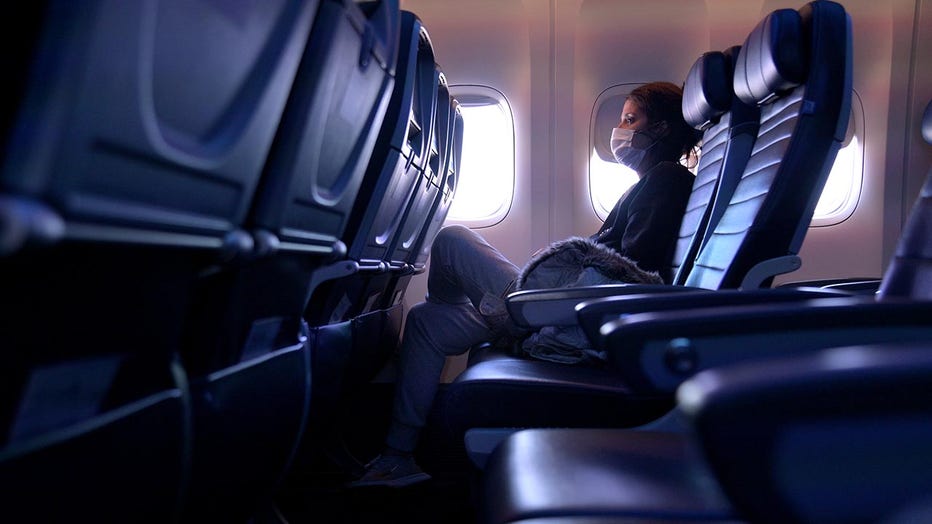Harvard study: Flying poses lower COVID-19 risk than grocery shopping with proper safety measures
BOSTON - Flying on an airplane could pose a lower risk of contracting COVID-19 than shopping at the grocery store or dining at a restaurant, a new report by Harvard researchers suggests.
A study published this week from scientists at Harvard T.H. Chan School of Public Health found that airlines can significantly reduce transmission of the virus by encouraging hand washing, requiring passengers and crew members to wear masks at all times, ensuring constant ventilation and air flow, and regularly cleaning and sanitizing planes.
The researchers found that this layered approach “reduces the risk of SARS-CoV-2 transmission onboard aircraft below that of other routine activities during the pandemic, such as grocery shopping or eating out,“ the report states.

A masked passenger is seen seated on a flight from San Francisco, California to Newark, New Jersey on Oct. 27, 2020. (Photo by Michael Loccisano/Getty Images)
The Aviation Public Health Initiative (APHI), a project of the Harvard T.H. Chan School of Public Health, published its Phase One report Oct. 27, analyzing "gate-to-gate" travel on planes and the risk of contracting the novel coronavirus.
The report states that commercial planes are equipped with “highly effective ventilation systems that refresh cabin air on average every 2-3 minutes, filtering air through High Efficiency Particulate Air (HEPA) filters” that remove more than 99% of particles in the air.
In addition to face masks and proper cleaning, the report calls for proper screening of passengers and crew — as well as education and awareness of COVID-19.
Researchers in the study concluded that the risk of coronavirus transmission on an aircraft is reduced “to very low levels” if all of these safety measures are done collectively.
The APHI is sponsored by a consortium of airline operators, aviation industry manufacturers and airport operators, according to Harvard. But the report states that the findings and recommendations in the report are “the independent conclusions” of the Harvard researchers.
“Until there has been widespread vaccination, there remains the risk of infection in all walks of public life. As with any activity during this pandemic, the choice to fly is a personal one and depends on a traveler’s health assessment, individual risk tolerance and the potential consequences of becoming infected,” researchers wrote in the report.
The second phase of the report will focus on the curb-to-curb airport environment, which will examine testing, the indoor air environment of airports, and other measures to reduce risk of COVID-19 spread.
According to the International Air Transport Association, there have been 44 cases of COVID-19 transmission thought to have been associated with flying since the start of 2020, out of some 1.2 billion passengers who have traveled during that time period.
A separate study released earlier this month by the Department of Defense in conjunction with United Airlines also found the risk of exposure on a plane to be low. Using a mannequin, researchers ran 300 aerosol release tests in order to replicate breathing and coughing.
During each test, approximately 180 million particles were released, which study authors said simulated the number of particles that thousands of coughs would produce. After studying the particle movement within the cabin with and without a face mask, researchers found that “approximately 99.99% of particles were filtered out of the cabin within six minutes” due to proper air ventilation and filtration systems on the plane.
RELATED: United Airlines-DOD study: Face masks make COVID-19 risk on flights ‘almost non-existent’
Dr. Linsey Marr, a professor at Virginia Tech with expertise in airborne transmission of viruses and air quality, said that while the Defense Department-United study was comprehensive, it did not account for all of the variables that could contribute to COVID-19 spread within an aircraft.
“The rate of emissions that they assumed, the amount of viruses that people are releasing into the air, was consistent maybe with breathing, but not with talking, with talking we would expect there to be 10 times more. So, in that case, the risk could be 10 times higher,” Marr said.
The studies come as major airline companies work to claw their way out of a financial disaster caused by the coronavirus pandemic. Boeing said this week that it will cut 7,000 additional jobs because the virus and related shutdowns have decimated the demand for new planes.
RELATED: United Airlines to make rapid COVID-19 tests available to some passengers
This story was reported from Cincinnati.


